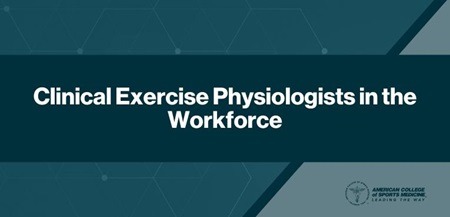Laura A. Richardson, Ph.D., FACSM |
April
4, 2022
 A clinical exercise physiologist (CEP) is an allied health professional trained to work with persons diagnosed with a chronic disease for which exercise training has been shown to be therapeutically beneficial. Such conditions include cardiovascular, pulmonary, metabolic, neuromuscular, immunological and orthopedic disorders, among others. Primarily, CEPs work in medically supervised environments providing programs or services directed by a licensed physician. The ACSM Certified Clinical Exercise Physiologist® (ACSM-CEP) credential is the gold standard certification and has the most rigorous educational requirements in the fitness industry. According to the U.S. Bureau of Labor and Statistics, the 2020-30 employment outlook for exercise physiologists is growing at a faster-than-average growth rate of 13%.
A clinical exercise physiologist (CEP) is an allied health professional trained to work with persons diagnosed with a chronic disease for which exercise training has been shown to be therapeutically beneficial. Such conditions include cardiovascular, pulmonary, metabolic, neuromuscular, immunological and orthopedic disorders, among others. Primarily, CEPs work in medically supervised environments providing programs or services directed by a licensed physician. The ACSM Certified Clinical Exercise Physiologist® (ACSM-CEP) credential is the gold standard certification and has the most rigorous educational requirements in the fitness industry. According to the U.S. Bureau of Labor and Statistics, the 2020-30 employment outlook for exercise physiologists is growing at a faster-than-average growth rate of 13%.
There has been much forward movement with both recognition of the profession and employment opportunities. The Clinical Exercise Physiology Association (CEPA), an affiliate society of ACSM, published the 2020 Clinical Exercise Physiology Practice Survey, reporting certified professionals earned higher median hourly wage than those who were not certified. Over the past few years, ACSM-CEPs earned 17% higher salaries than wages reported in the 2015 salary survey. Additionally, individuals with a master’s degree and ACSM certification reported $7,500 higher earnings than those without certification.
ACSM-CEPs are dedicated to improving clients’ quality of life through individualized prescribed exercise and behavior-change interventions to address and attenuate declines in fitness and health. Working with a wide variety of populations, the ACSM-CEP provides primary and secondary strategies promoting physical activity for children to older adults. Employers range from collaborative care and multidisciplinary teams in hospitals or physician-based programs to self-employed, direct-pay employment settings.
Common areas for ACSM-CEP employment
- Cardiac rehabilitation
- Cardiovascular stress testing
- Exercise oncology
- Diabetes and exercise
- Bariatric and weight management
- Neurological rehabilitation
- Pulmonary rehabilitation
- Pediatrics congenital cardiovascular testing
- Primary prevention programs
- Commercial/community fitness center
- Medical fitness center
- Nonuniversity/clinical research
- Corporate wellness
Current need for certified exercise professionals
The COVID-19 pandemic has amplified levels of habitual inactivity, increasing levels of overweight and obesity and decreasing cardiorespiratory fitness. Many individuals present with physical limitations and chronic diseases (e.g., diabetes mellitus) warranting safe and effective physical activity programming. The pandemic created a shift in the mode of delivery, with many exercise centers and clinics pivoting to virtual, home-based settings and digital fitness. Albeit a common transition during the pandemic, delivering primary and secondary exercise programing continues to grow with innovative infrastructure. Many current job vacancies describe academically prepared exercise professionals with adaptable and flexible skill sets to meet the varying modes of delivery for hybrid workspace to mitigate barriers to exercise adherence.
There is also the potential to see an uptick in ACSM-CEPs employed in clinical settings commonly staffed by registered nurses (e.g., cardiac rehab, cardiovascular stress testing) due to the ongoing nursing shortage. A recent publication supports the idea that ACSM-CEPs are specifically prepared to evaluate the acute and chronic responses to exercise and likely better suited for those roles than other allied health professionals. ACSM-CEPs are among the only allied health care providers specifically trained to develop exercise prescriptions and provide risk-factor modification counseling in the management of chronic disease.
Action items for professionalism
Professional membership can be very valuable during the job search process. Both ACSM and CEPA are key organizations that continually post job vacancies. Some other tips to keep in mind when seeking employment:
- Craft a well written resume — highlight specific skills and experience
- Network — contact past employers, professors, internship mentors
- Social media — use LinkedIn, ACSM Careers, and other job-search platforms
- Recognize CEP synonyms — some organizations may use terms other than “clinical exercise physiologist” in job titles, including “exercise physiologist,” “exercise specialist,” “exercise trainer,” “health educator,” or “wellness coordinator.” Be sure to read job descriptions carefully prior to applying.
As the profession continues to grow, ACSM-CEPs must advocate for advancement by encouraging other skilled exercise professionals to become certified. Additionally, ACSM-CEPs are eligible for an individual a National Provider Identifier (NPI). Registering for one will help expand recognition of the profession as critical members of health care teams.
Increasing life expectancy continues to fuel the growth of allied health professions, which are projected to grow at more than double the rate of other occupations. ACSM-CEPs’ proficiency at administering chronic disease management commonly found in both primary and secondary settings widens their potential employment opportunities. There’s a lot of momentum behind implementing physical activity and therapeutic exercise!
Related content:
Blog | How ACSM-EPs and ACSM-CEPs Can Advance the Profession’s Recognition, Compensation
 Laura A. Richardson, Ph.D., ACSM-CEP, RCEP, FACSM, president of the Clinical Exercise Physiology Association (CEPA) and Clinical Associate Professor of Applied Exercise Science and Movement Science in the University of Michigan School of Kinesiology. Dr. Richardson is a Registered Clinical Exercise Physiologist® (RCEP®) with over two decades in health care working with patients diagnosed with immunological, metabolic, pulmonary, neuromuscular, cardiovascular and orthopedic disorders using exercise as a mode of therapeutic intervention. Her expertise is working with metabolic patients utilizing behavior-modification strategies for lifelong weight management with bariatric surgery, along with advocating for the advancement of the CEP profession.
Laura A. Richardson, Ph.D., ACSM-CEP, RCEP, FACSM, president of the Clinical Exercise Physiology Association (CEPA) and Clinical Associate Professor of Applied Exercise Science and Movement Science in the University of Michigan School of Kinesiology. Dr. Richardson is a Registered Clinical Exercise Physiologist® (RCEP®) with over two decades in health care working with patients diagnosed with immunological, metabolic, pulmonary, neuromuscular, cardiovascular and orthopedic disorders using exercise as a mode of therapeutic intervention. Her expertise is working with metabolic patients utilizing behavior-modification strategies for lifelong weight management with bariatric surgery, along with advocating for the advancement of the CEP profession.